Your cart is currently empty!
The allure of car camping lies in the freedom it offers – the ability to explore new horizons and set up a comfortable basecamp with relative ease. At the heart of any successful car camping adventure is the shelter that protects you from the elements and provides a restful night’s sleep: your tent.
With a vast array of options available, selecting the ideal tent can feel overwhelming. However, understanding the different types and key features will empower you to make the right choice and enhance your outdoor experiences.
Among the various styles, “tailgate tents” are gaining popularity among car campers for their unique integration with vehicles, offering an added layer of convenience and functionality. This guide will navigate you through the essential considerations to help you discover the perfect camping tent for your next journey.
What Kind of Car Camper Are You? Finding Your Tent Soulmate
The notion of the “perfect” camping tent is inherently personal, varying based on individual camping habits and preferences. Before diving into the specifics of tent types and features, it’s beneficial to reflect on your typical camping scenarios.
Consider how often you plan to embark on camping trips. Are they frequent weekend getaways or longer, more involved excursions? This frequency can influence your priorities, with frequent campers potentially valuing long-term durability and a wider range of features, while those camping occasionally might prioritize budget-friendliness and straightforward setup.
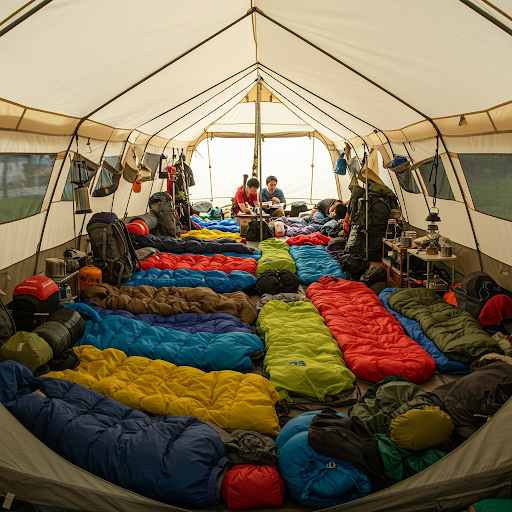
The number of people you typically camp with is another crucial factor. Are you a solo adventurer seeking a cozy shelter, a couple looking for a comfortable retreat, or a family or group of friends needing more spacious accommodations?
The size of your camping party directly dictates the required capacity of your tent and the importance of features like multiple doors for ease of access. Furthermore, the typical weather conditions you expect to encounter play a significant role in your tent selection.
Do you primarily camp under sunny skies, or are you likely to face rain, wind, or a mix of conditions? Understanding the prevailing weather patterns will help you determine the necessary level of weather resistance and ventilation your tent should offer.
Finally, assess your gear storage needs. Do you travel light with just the essentials, or do you require ample space for larger items like bikes, kayaks, or climbing equipment? This will influence whether you need a tent with a large vestibule or if a larger overall tent size is more appropriate.
Taking the time to consider these aspects of your car camping style will lay the foundation for choosing a tent that truly meets your needs.
Decoding the Tent Types for Car Camping: A Roof Over Your Wheels
Car camping offers the flexibility to choose from various tent types, each with its own set of characteristics and benefits. Understanding these categories will help you narrow down your options.
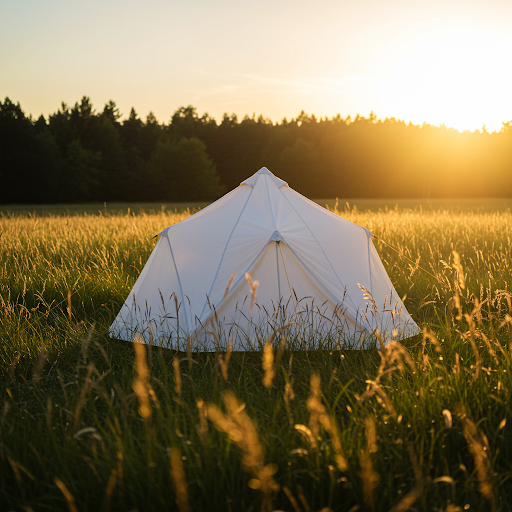
Traditional Ground Tents:
- Dome Tents: These are perhaps the most ubiquitous type of camping tent, recognized for their dome-like shape created by two or more flexible poles that cross at the peak. Many dome tents are known for their relatively easy setup, making them a popular choice for beginners and experienced campers alike. They often offer a good balance of weight and space, and are available in a wide range of capacities, from solo shelters to tents accommodating larger groups. The curved walls of dome tents can provide ample headroom in the center, though the space may taper off towards the edges. While generally lightweight and easy to carry, larger dome tents can sometimes be more susceptible to strong winds due to their shape.
- Cabin Tents: As the name suggests, cabin tents are designed with a more boxy shape and near-vertical walls, maximizing interior space and providing excellent headroom throughout the tent. This design often makes them feel more spacious and comfortable, particularly for longer stays or when camping with families. Some cabin tents even include room dividers and awnings, further enhancing livability. While offering superior space, cabin tents can sometimes have a more complex setup involving more poles, and their larger, more upright profile may make them less stable in high winds compared to dome tents.
- Instant Setup Tents: For car campers who prioritize speed and convenience, instant setup tents are a game-changer. These tents utilize pre-attached poles or a hub system that allows them to be pitched in a matter of minutes, sometimes even seconds. This ease of setup is particularly appealing when arriving at a campsite late or when you want to spend less time setting up and more time enjoying the outdoors. While incredibly convenient, instant tents may sometimes be slightly heavier or bulkier when packed compared to traditional pole tents, and some models might not offer the same level of durability or weather resistance as more robustly constructed tents.

Spotlight on Tailgate Tents: Your Car as Part of the Camp:
A specialized category that caters directly to car campers is the “tailgate tent“. These tents are ingeniously designed to integrate seamlessly with the rear of your vehicle, transforming your car into an integral part of your campsite.
Typically attaching to the tailgate or hatch area, they create a versatile extension of your vehicle, which can serve as an additional sleeping space, a convenient storage area for gear, or a sheltered and bug-free lounge.
Tailgate tents offer several compelling advantages for car campers. Their seamless integration with the vehicle provides easy access to items stored inside your car, as well as the potential to utilize the car’s power outlets for charging devices or running small appliances.
By extending the usable space beyond the main tent body, they offer extra room for gear organization, changing clothes, or simply stretching out. Many tailgate tents are designed to create a fully enclosed space, offering reliable protection from the elements like rain and sun, as well as keeping pesky insects at bay.
Furthermore, many models are engineered for relatively easy and quick setup, aligning with the convenience that car campers typically seek. This unique integration of the vehicle into the camping setup makes tailgate tents a highly functional and appealing option for those who prefer to camp with their car nearby.
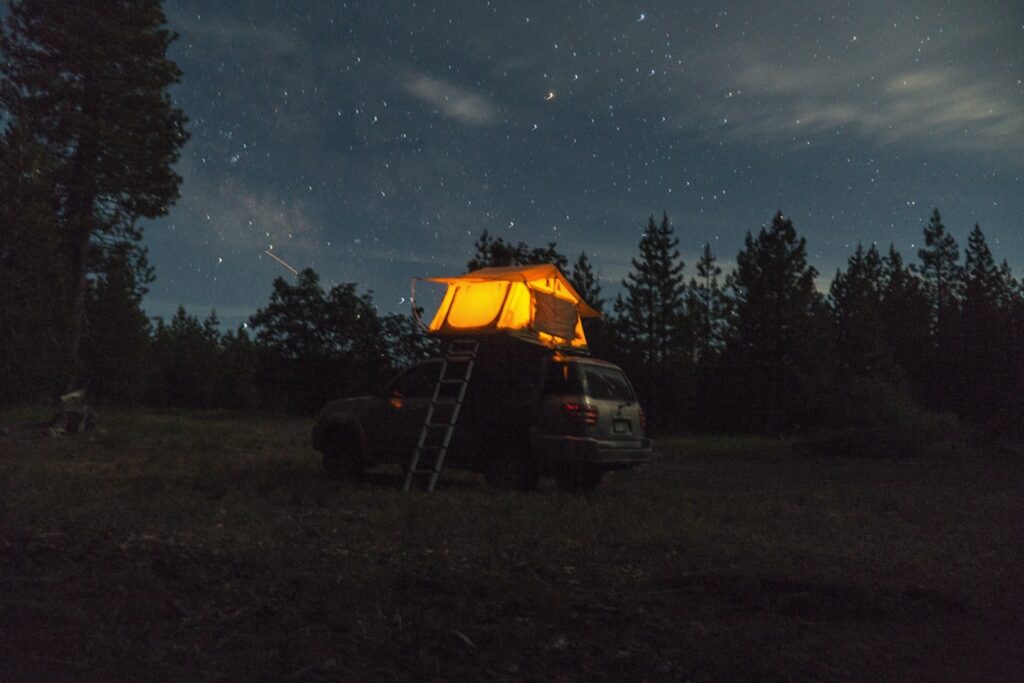
A Brief Look at Rooftop Tents:
Another notable option for car camping, though distinct from traditional ground tents and tailgate tents, is the rooftop tent. As the name suggests, these tents mount directly onto the roof of your vehicle, providing an elevated sleeping platform.
A significant benefit of rooftop tents is their incredibly quick setup, often deploying in just a minute or two. Being off the ground offers advantages such as avoiding uneven terrain, potential flooding, and some ground-dwelling pests.
Many rooftop tents also feature a built-in mattress, adding to the comfort factor. However, rooftop tents generally come with a higher price tag compared to ground tents , and their added weight on the vehicle’s roof can sometimes impact fuel efficiency.
Key Features to Consider When Choosing: The Nitty-Gritty Details
Once you have a general idea of the type of tent that might suit your needs, it’s important to delve into the specific features that differentiate camping tents.
Weathering the Storm: Understanding Waterproofing and Wind Resistance:
A crucial aspect of any camping tent is its ability to protect you from the elements. The rainfly, a separate waterproof cover that goes over the tent’s roof, is essential for keeping rain out. Look for tents with waterproof coatings applied to the tent fabric and rainfly, often indicated by a millimeter rating (e.g., 1500mm, 2000mm).
Additionally, ensure that the tent has sealed seams, which prevent water from seeping through the stitching. For maximum protection, especially in heavy rain or windy conditions, a full-coverage rainfly that extends down to the ground is recommended.
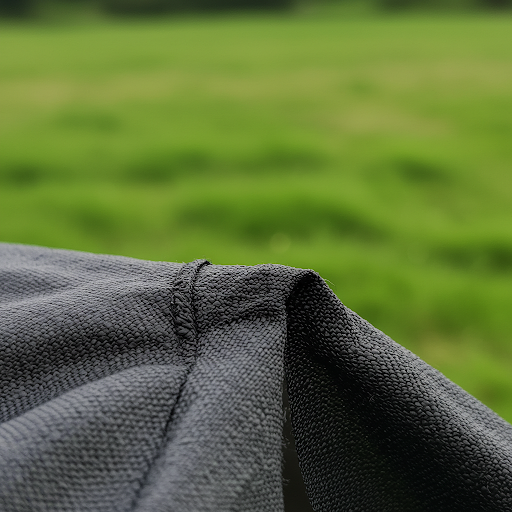
The denier of the fabric, which measures the thickness of the fibers, also plays a role in durability and wind resistance, with higher denier fabrics generally being more rugged. The material of the tent poles (aluminum being stronger and more durable than fiberglass) also contributes to the tent’s overall stability in windy conditions.
Setup Simplicity: Getting Your Campsite Ready Quickly:
For car campers, ease of setup is often a significant consideration, as they typically value convenience and want to spend minimal time struggling with tent assembly. Look for features that simplify the setup process, such as color-coded poles and corresponding sleeves or clips on the tent body.
Clip attachments are often considered easier to use than threading poles through long sleeves. As mentioned earlier, instant setup tents offer the ultimate convenience in this regard, often utilizing a pre-attached frame or hub system that allows for incredibly fast pitching.
Breathability and Ventilation: Staying Comfortable Inside:
Proper ventilation is key to a comfortable camping experience, as it helps to prevent the buildup of condensation inside the tent, which can lead to dampness and discomfort.
Look for tents with ample mesh panels in the ceiling, doors, and windows, as these allow for good airflow. Vents located in the roof or near the ground can also enhance cross-ventilation.
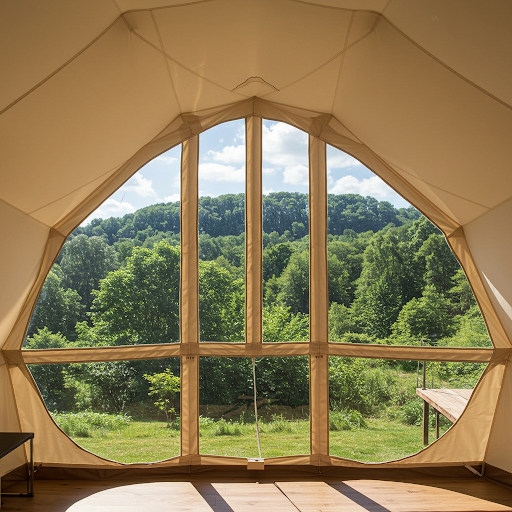
Double-wall tents, which feature a breathable inner tent and a separate waterproof rainfly, generally offer better ventilation than single-wall tents, where the waterproof layer also serves as the main tent body. Multiple doors can also improve airflow by allowing for cross breezes.
Doors and Vestibules: Easy Access and Gear Storage:
The design and number of doors can greatly affect the convenience of using a camping tent. Multiple doors, especially in larger tents, make it easier for occupants to enter and exit without having to climb over each other.
Vestibules are covered areas located outside the main tent doors, often created by the extended rainfly. These are invaluable for storing muddy boots, backpacks, and other gear, keeping the interior of the tent clean and dry.
Bonus Features: Pockets, Gear Lofts, and More:
Many camping tents come equipped with additional features that can enhance your camping experience. Interior pockets sewn into the tent walls provide convenient storage for small items like headlamps, phones, and eyeglasses, keeping them organized and easily accessible.

Lantern loops located at the center of the tent ceiling allow you to hang a light source. Gear lofts, which are mesh shelves that attach to the interior of the tent, offer additional off-the-floor storage space for larger items.
Tent Materials Explained: From Nylon to Canvas
A closer look at the materials commonly used in camping tents reveals their distinct characteristics and how they contribute to the overall performance of the shelter.
- Nylon: Often favored for its light weight, nylon is a strong and relatively affordable fabric commonly used in tent bodies and rainflies. It offers good water repellency, especially when treated with waterproof coatings. However, nylon has a tendency to stretch, particularly when it gets wet, which can sometimes lead to sagging. It is also susceptible to degradation from prolonged exposure to ultraviolet (UV) rays, which can weaken the fabric over time. To enhance tear resistance, many high-quality tents utilize ripstop nylon, which incorporates a reinforced grid pattern that helps to contain any tears.
- Polyester: Another popular synthetic fabric for tents, polyester offers several advantages over nylon. It exhibits better resistance to UV degradation, meaning it will maintain its strength and color longer when exposed to sunlight. Polyester also does not stretch as much as nylon, even when wet, helping the tent maintain its shape. It generally offers good water resistance and is often used for rainflies and tent bodies. While typically heavier than nylon, polyester can be a more durable option in the long run.
- Canvas: For campers seeking maximum durability and breathability, canvas tents are a time-tested choice. Made from cotton or cotton blends, canvas is incredibly robust and can withstand years of use. Its breathability helps to reduce condensation inside the tent and makes it comfortable in a wider range of temperatures, keeping it cooler in the summer and warmer in the winter. However, canvas is significantly heavier and more expensive than synthetic fabrics. It also requires more maintenance, including proper seasoning when new to ensure water resistance and careful drying to prevent mildew.
- Coatings (PU vs. Silicone): To achieve waterproofness, tent fabrics are typically treated with coatings. Polyurethane (PU) coatings are commonly used and provide a good level of water resistance. However, PU coatings can add weight to the fabric and may degrade over time through a process called hydrolysis, leading to stickiness and peeling. Silicone coatings, on the other hand, such as those found in silnylon (silicone-coated nylon) and silpoly (silicone-coated polyester), are generally lighter, stronger, and more durable than PU coatings.They also do not suffer from hydrolysis. While they can be more expensive, silicone coatings often offer superior long-term performance.

Budget-Friendly vs. Premium: What to Expect at Different Price Points
The price of a camping tent often reflects its quality, features, and the materials used in its construction. Understanding what to expect at different price points can help you make a decision that aligns with your budget and needs.
In the budget-friendly category, typically under $200-$250, you can expect to find tents with basic features and simpler materials. These tents often utilize polyester fabrics with PU coatings and may have a focus on ease of setup.
Sizes might be slightly smaller, and while they will provide basic shelter, their long-term durability and weather resistance might be limited. Brands like Coleman and some Ozark Trail models often fall into this price range.
Moving into the mid-range, between $250 and $500, you’ll generally find tents with better quality materials, such as ripstop nylon or higher-denier polyester with more durable coatings. These tents often offer more features, including multiple doors, larger vestibules, and improved ventilation systems.
You can expect a noticeable step up in durability and weather resistance compared to budget-friendly options. Brands like Kelty, and lower-end models from REI Co-op often fall within this price range.
At the premium level, above $500, you’ll encounter tents constructed with high-end materials like silnylon or canvas, featuring advanced designs and exceptional durability and weather resistance. These tents often prioritize comfort and livability, with features like generous interior space, tall peak heights, and thoughtful storage solutions. Brands like NEMO, Big Agnes, Snowpeak, and higher-end offerings from REI Co-op typically occupy this category.
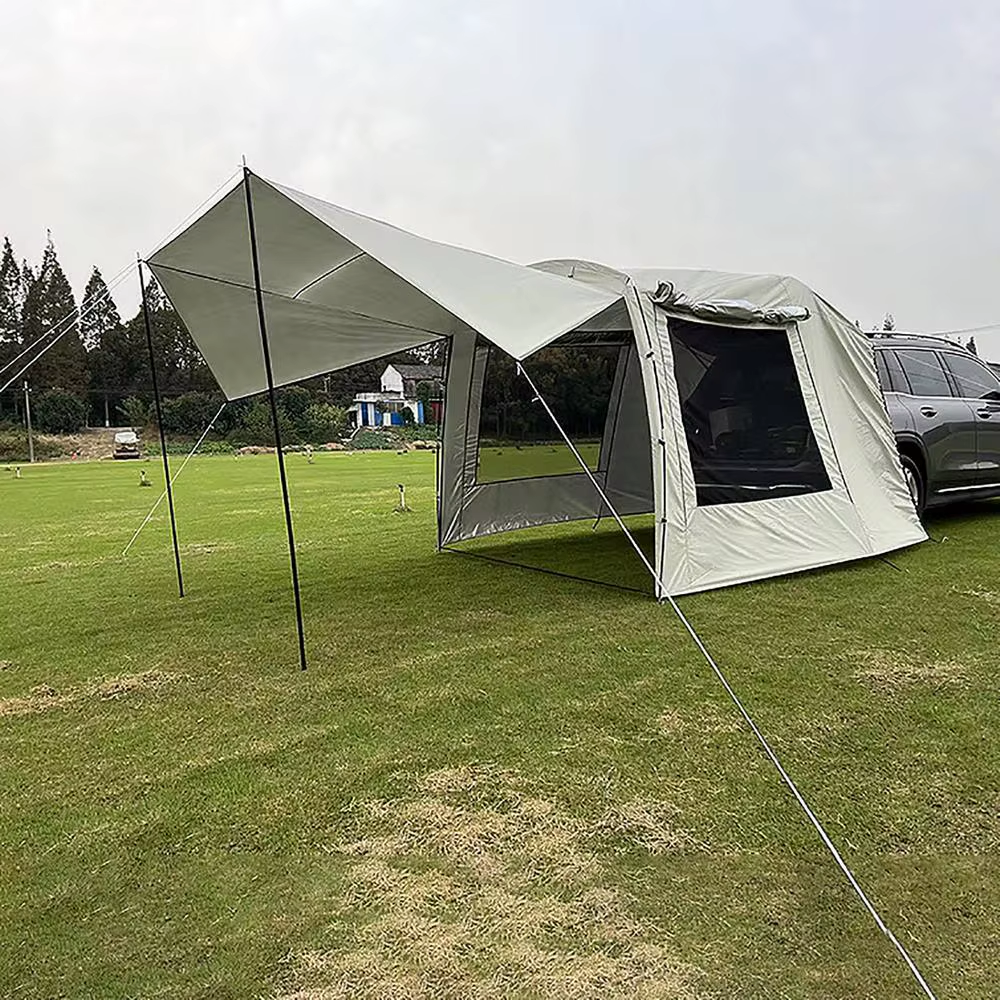
The price range for tailgate tents can vary depending on the style and features. Simpler canopy-style tailgate tents designed primarily for shade might be found in the more budget-friendly range.
However, tailgate tents with more robust construction, integrated flooring, bug netting, and higher-quality materials could fall into the mid-range or even higher price points.
Popular Tent Brands and Models for Car Camping Adventures
When it comes to choosing a camping tent for car camping, several brands and models stand out for their quality, features, and suitability for this style of outdoor adventure.
Ground Tent Recommendations:
NEMO Aurora Highrise: Praised for its supreme livability, easy setup, and effective weather protection, the NEMO Aurora Highrise is a popular choice for families and those who value comfort.
Big Agnes Big House Car Camping Tent: Known for its remarkably easy setup, the Big Agnes Big House offers generous interior space and is a great option for campers who prioritize convenience.
Coleman Skydome: A budget-friendly option that doesn’t compromise too much on quality, the Coleman Skydome is popular for its quick setup and surprising robustness for the price.
Kelty Discovery Element: Recognized as a best value pick, the Kelty Discovery Element is affordable, easy to set up, and offers good weather protection. The Kelty Late Start is also noted for its ease of setup and breathability.
Eureka Copper Canyon: With its cabin-like design and near-vertical walls, the Eureka Copper Canyon offers excellent interior space and headroom, making it ideal for families. Get it before it’s gone! Eureka tent are no longer being manufactured.
REI Co-op Wonderland: Designed with families in mind, the REI Co-op Wonderland boasts a spacious interior, a room divider for privacy, and numerous storage pockets. The REI Half Dome is another well-regarded option known for its all-around performance.
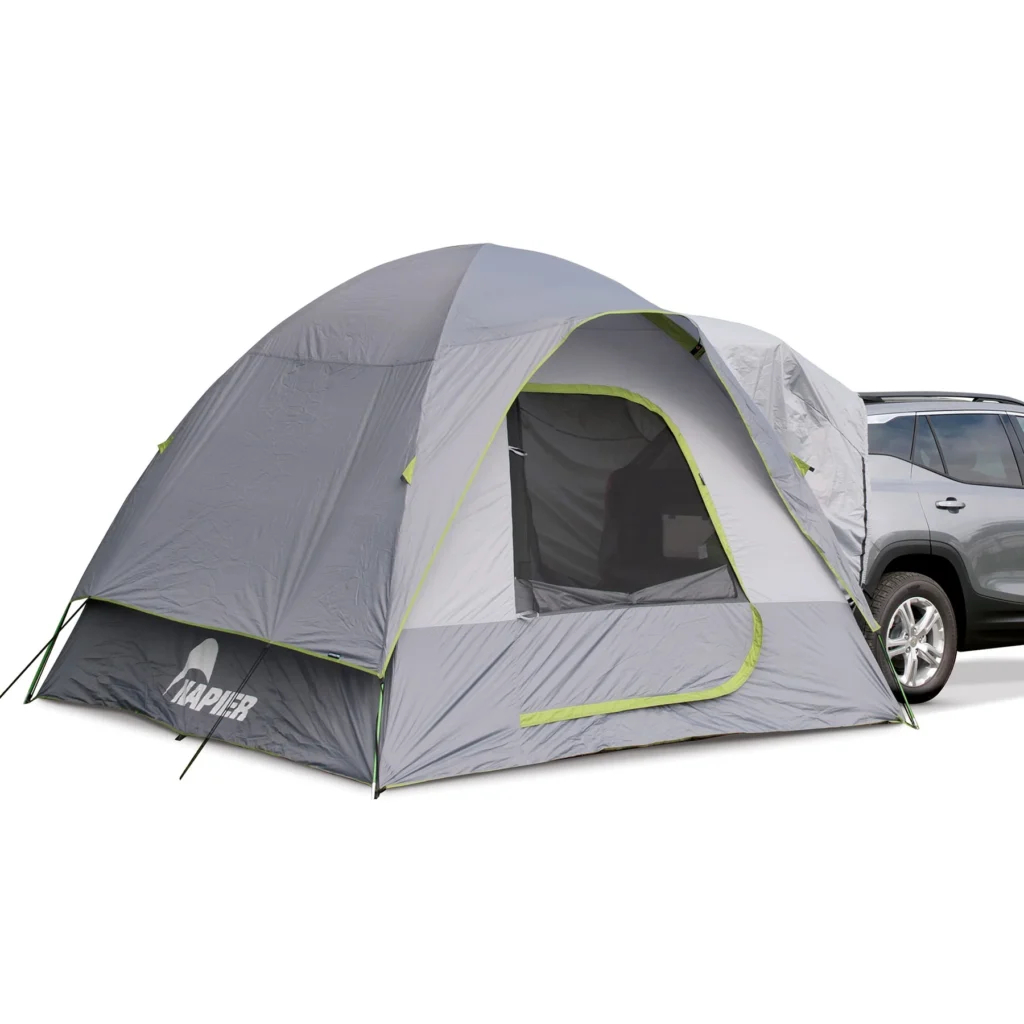
Tailgate Tent Recommendations:
| Brand | Model | Key Features | Price Range |
|---|---|---|---|
| Napier | Backroadz SUV Tent | Attaches to SUV tailgate, spacious interior, can sleep 5-7 people, some models with screen rooms | Mid-Range |
| UNIHIMAL | SUV Tent for Camping | Universal fit for most SUVs, easy setup, provides shaded retreat, waterproof and UV resistant | Budget-Friendly |
| MoonShade | Portable Vehicle Awning | Attaches to various vehicles, provides shade and shelter, lightweight and portable | Mid-Range |
| Dometic | Tailgater | Universal fit inflatable awning for vehicles with rear hatch, waterproof polyester, easy multi-point inflation | Mid-Range |
| TailVeil | (Various Models) | Bug-proof tents that attach to the rear of vehicles, some with flooring | Mid-Range |
| Hasika | SUV Camping Tent Car Tailgate Shade Awning | Attaches to tailgate, some models with screen net, waterproof and UV resistant | Budget-Friendly |
| Kampa | Tailgater Poled Awning | Attaches to vehicle tailgate, provides extra space and usability | Mid-Range |
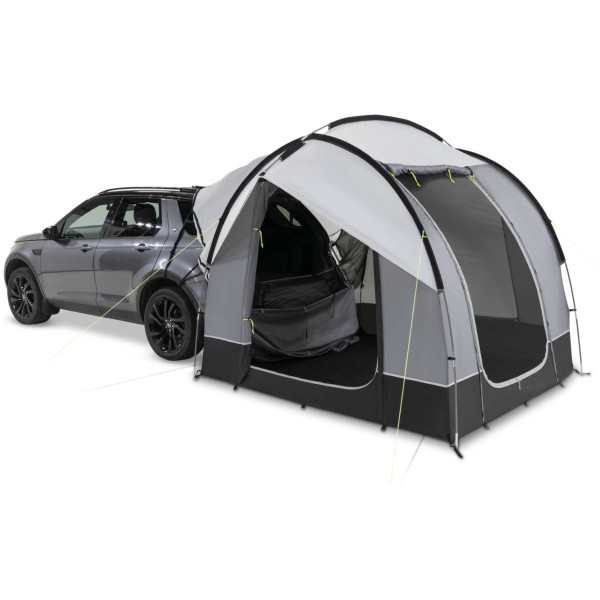
Avoiding Common Camping Tent Headaches: Troubleshooting Tips
Even the best camping tents can sometimes encounter problems. Being prepared to address these issues can save your trip from becoming uncomfortable.
Leaks are a common concern, often occurring at the seams. Regularly inspect and seam seal your tent, especially before a trip. Ensure you use the correct type of seam sealer for your tent’s fabric. Also, remember that condensation can sometimes be mistaken for leaks, so ensure proper ventilation by opening vents and windows.
Rips and tears in the tent fabric or mesh can happen due to sharp objects or accidental snags. Carry a tent repair kit that includes patches and adhesive to quickly fix any damage. Clean the area around the tear with rubbing alcohol before applying the patch for better adhesion.
Broken tent poles can be a major setback. Many tents come with a pole repair sleeve, which can be slid over the broken section and secured with tape for a temporary fix. In a pinch, a tent stake can also be used as a splint. However, it’s always best to replace the broken pole section when you return home.

Sticky zippers can be frustrating. First, ensure there is no fabric caught in the zipper. If it’s still sticking, try cleaning the zipper teeth with a brush to remove any dirt or debris. You can also use a zipper lubricant or even an unscented candle rubbed along the teeth for a temporary fix.
In windy conditions, proper staking and the use of guy lines are crucial to prevent damage to your tent. Ensure all stakes are firmly planted at an angle, and use guy lines to secure the tent body and rainfly, providing added stability.
For those using inflatable tents, the risk of punctures is a consideration. Always use a ground footprint to protect the tent floor from sharp objects. Carry a repair kit specifically designed for inflatable tents, which typically includes patches and adhesive, and know how to locate and repair leaks.
Conclusion: Your Perfect Camping Tent Awaits
Choosing the perfect camping tent for your car camping adventures involves considering several key factors, including your camping style, the number of campers, typical weather conditions, and gear storage needs. Understanding the different types of tents available, from traditional dome and cabin tents to convenient instant setup models and the increasingly popular tailgate tents, will help you narrow down your options.
Paying attention to essential features like size and capacity, weather resistance, ease of setup, ventilation, durability, and the design of doors and vestibules is crucial for selecting a tent that meets your specific requirements. Tailgate tents offer a unique advantage for car campers by seamlessly integrating with their vehicles, providing extended living space, easy access to amenities, and enhanced convenience.
By considering your budget and exploring the offerings of various reputable brands and models, you can confidently choose a camping tent that will serve as your comfortable and reliable home away from home on countless road trips and outdoor excursions.
Ready for Your Next Adventure?
Explore our recommended tailgate tents and find the perfect shelter for your next car camping trip!


Leave a Reply